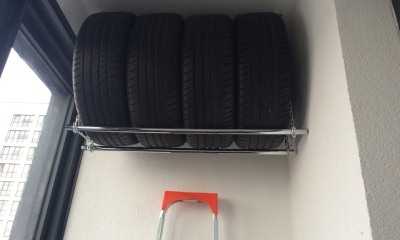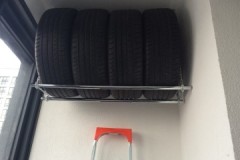 Car owners ask themselves the question of storing tires at least twice a year: when replacing summer tires with winter tires and vice versa.
Car owners ask themselves the question of storing tires at least twice a year: when replacing summer tires with winter tires and vice versa.
If done incorrectly, the service life of wheels is significantly reduced - they can be subject to deformation and cracking, and may lose elasticity.
Recommendations for seasonal tire storage are not complicated, but they have certain nuances. Read on to learn how to properly store tires (standing or lying down, at what temperature, etc.).
Content
Where is the best place to keep the wheels?
If you store tires without paying special attention to the place, then in just one season you can worsen their performance.
It is important not to expose tires to adverse factors, destructively affecting their structure:
- high humidity;
- direct sunlight;
- high temperature;
- pollution.
These reasons can cause premature tire wear.
Can it be stored on the balcony?
 You can store wheels on the balcony if comfortable conditions have been created for them: there is a large space with heating and ventilation.
You can store wheels on the balcony if comfortable conditions have been created for them: there is a large space with heating and ventilation.
It is recommended to cover them with a cover made of synthetic material. Tires cannot be left on an open, unglazed balcony.
Here they will be exposed to all unfavorable factors simultaneously:
- the strength of precipitation;
- sudden changes and exposure to temperatures;
- influence of condensate:
- settling of dust.
Read more Here.
In the garage
You can put your tires in the garage for the season, provided that it is heated and well ventilated. In this case, it is not recommended to place them on the floor; it is best to use a rack or stand.
Not suitable for storing wheels in a metal garage, since the conditions inside it are not quite suitable for this purpose:
- In winter, exposure to low temperatures and condensation occurs.
- In summer there is strong heating from the sun.
Details - in this article.
At the tire storage center
If it is not possible to find a place, then you can store tires in specialized points. This service is provided by such organizations as:
- service center;
- tire service;
- tire center;
- tire stores equipped with warehouses.
Such organizations must provide a guarantee for the proper storage of tires and strict compliance with the relevant standards responsible for the conditions.
In the attic
 Owners of private homes have the opportunity to place tires in the attic. It is only necessary to observe some nuances:
Owners of private homes have the opportunity to place tires in the attic. It is only necessary to observe some nuances:
- The rack where the rubber will be installed should be located away from the window to prevent exposure to sunlight.
- The roof must be sealed and moisture must not be allowed to penetrate during the rainy season.
Proper maintenance in the cellar
A basement can be a great place to store tires if it is heated and ventilated. It is only important to position them correctly and then the wheels will not lose their original qualities at all.
It is worth placing them higher from the floor, using a tray, since in spring it is impossible to exclude the possibility of flooding the cellar with melt water.
Basic rules and requirements
Before sending rubber for storage, in order to avoid loss of its performance characteristics and extend its service life, It is worth following simple rules:
- Clean off dirt and road reagents, remove stuck pebbles from the treads, dry and treat with a preservative.
- Make marks on the tires (for example, LP - left front, LZ - left rear, PP, PZ). Such markings will help put the wheels in their original places.
- If possible, put special packaging covers on the tires without tying them. Do not use polyethylene bags for this purpose, since rubber requires air exchange.
How should tires be stored on rims?
There are two ways to save using this method:
- stack in a lying position;
- in a suspended state, with fastening to the disk.
Before sending wheels for storage, it is necessary to check the pressure in them. The indicator should not be too low, optimally 2.2 bar. To hang tires on the wall, hooks are used, which must be attached to the holes of the disks.
It is recommended to rotate the tires on the rims every 1.5-2 months, changing their placesto normalize the pressure created when the upper wheels interact with the lower ones. The air should be the same temperature around the entire stack so that each element is exposed to equal conditions. Details - in this article.

In what position should you keep tires without rims?
Without discs, tires can only be stored in a standing position, vertically, resting on the tread. They need to be placed close to each other or using a support. In this case, you should avoid squeezing the wheels together.
If you stack them, the lower tires will begin to change shape under the weight of the upper ones. Hanging is also not allowed - deformation will occur due to its own weight. Details - in this article.

Tire processing
A big advantage will be the treatment of rubber after cleaning with a special agent. For this purpose, substances based on neutral silicone are suitable. In addition to its protective function, it has the ability to get rid of excess moisture in microcracks.
Read more here.
Conditions: at what temperature, humidity?
There are standards in accordance with GOST, which spell out the most optimal requirements for storage conditions for automobile wheels. Standards in the Russian Federation are similar to European ones.
Key aspects:
- Temperature: +20° +25°C.
- Relative humidity indicator: 60-70%.
- Elimination of exposure to direct rays of the sun, which destroy the structure of rubber.
- The location of the tires is at least one meter away from the heating source.
- Ensure good ventilation in the storage area.
It is unacceptable to use equipment near the location of the tires, during the operation of which various gases, ozone, and water vapor are released into the environment. They should also not react with copper and metal elements that cause corrosion.
Is it possible to leave it in the cold?
 When storing the tire set indoors with sub-zero temperatures or outdoors, later you can get a negative result:
When storing the tire set indoors with sub-zero temperatures or outdoors, later you can get a negative result:
- the product will crack and may eventually burst during use;
- uneven areas form in the rubber structure;
- deformation - difficulties will arise during reinstallation and balancing.
When exposed to critically low temperatures, tires lose elasticity and become brittle.
Features - winter and summer
There are certain differences between storing winter tires and summer tires:
- Since winter tires are softer in structure, it is therefore recommended to leave them together with the disks, adjusting the pressure to 1.5 atm.
- Due to the deep tread, winter tires must be protected from the sun and protected from high temperatures.
When placing the wheels in a warm room, it is necessary that the distance from them to the heating source is at least one and a half meters.
How can you not?
When storing tires, it is better to follow the rules; this will help preserve their basic qualities and extend their life. But there are things that should not be reproduced:
- Use force when storing in a narrow place, push tires. They must be in free space.
- Do not adhere to the temperature regime.
- Place heating equipment or heating devices nearby.
- Place rubber on uneven or ribbed surfaces.
- Pile the kit on top with heavy objects.
- Allow exposure to moisture.
- Pack tire kits in plastic bags.
- Fold in the wrong position.
- Leave for storage in open areas and on the street, where tires may be exposed to the external environment (precipitation, sun, wind).
- Store tires in the living space or on the landing.
Consequences of improper storage
 When changing seasonally, tires should be carefully inspected. Signs of improper storage are:
When changing seasonally, tires should be carefully inspected. Signs of improper storage are:
- the appearance of cracks, hernias, delaminations - if there was exposure to sunlight, this will be visually noticeable;
- loss of elasticity and strength - the rubber has become “wooden”, which means there was a violation of the temperature regime;
- distortion of the shape of the cord and sidewall.
The consequences of storing in violation of the rules can lead to trouble:
- the tire may burst while driving due to a crack or “bump”;
- the car may lose its smooth running due to inelasticity and “hardening” of the rubber;
- Wheel disassembly may occur while driving.
Conclusion
Seasonal storage of a set of tires in compliance with the necessary rules will ensure comfort when driving and will maximize the service life of the tires.
By following simple recommendations, you can postpone the purchase of new tires and save the car owner’s budget.




